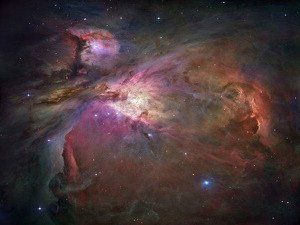Starwatch January 2011

The morning sun starts coming earlier in January, but even it can’t upstage Venus. The grande dame of planets opens the second decade of our young century with a dazzling display in the eastern predawn sky.
Revelers who stay up into the wee hours on the 1st—or any day in January, for that matter—will have no trouble spotting it. As the month goes by, S-shaped Scorpius rears above the horizon and slithers past Venus. Can you see the color difference between the white planet and Antares, the scorpion’s red heart? Look on the 16th or 17th, when the two objects will be close and no moon will interfere.
Saturn, in Virgo, is well up in the south at dawn. If you have a small telescope, consider braving the early morning cold to get a glimpse of its rings, which now tilt nearly 10 degrees from horizontal to give the planet a deeper 3-D appearance. If you spot a dark gap in the rings where they curve behind the northwestern edge of the planet’s disc, count yourself lucky; you have just seen Saturn’s shadow.
A recent study suggests that the rings were formed by ice torn from a large moon as it spiraled down into Saturn. If this “lost moon” idea is correct, it could help explain why the rings contain so much ice and so little rock, unlike other solar system bodies like meteors and comets.
Southeast of Saturn, Spica represents an ear of grain in the virgin’s hand. The brightest star in Virgo, Spica actually consists of two stars orbiting each other every four days. The larger has 10 times the mass of our sun and is 12,000 times brighter, while the smaller weighs in at seven times the mass and 1,500 times brighter. Even from a distance of 260 light-years, this caliber of candlepower is enough to make Spica the 15th brightest star in the sky.
Jupiter, second only to Venus in luminosity, is the leading light in the evening sky, shining after nightfall in the southwest. It has company this month in the form of Uranus, a dim giant that you’ll need a small telescope or a steady pair of good binoculars to see. We get our best chance an hour and a half after sunset on the 3rd, when Uranus will be half a degree—one full moon width—to the upper right of Jupiter.
In the east, the bright winter stars are coming into their own. Sirius, the brightest star in the sky, hangs low in the south in Canis Major, the larger of Orion’s two hunting dogs. Orion himself anchors the knot of familiar constellations that also includes Gemini and Taurus. Below the three stars of Orion’s belt hangs his sword, home of the Orion Nebula, an immense cloud of gas in which stars are being born.
January’s full moon arrives on the 19th. It will be only two hours past perfect fullness when it rises and will shine all night. Algonquin tribes called it the wolf moon, for the hungry howling of the wolves this time of year.
Earth reaches perihelion, its closest approach to the sun, at 12:34 p.m. on the 3rd; at that moment we’ll come a mere 91.4 million miles from our parents star. And speaking of close encounters, University of Minnesota physicists are building instruments for Solar Probe Plus, a NASA spacecraft that will zoom in to a sizzling 4 million miles from the sun. Data from SPP will shed light on why the sun’s corona is so much hotter than its surface and how the corona accelerates ions into the high-speed, 3-D stream of particles known as the solar wind.
The University of Minnesota offers public viewings of the night sky.
For more information and viewing schedules, visit the Twin Cities campus Department of Astronomy: www.astro.umn.edu/outreach/pubnight.
